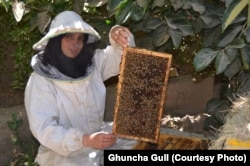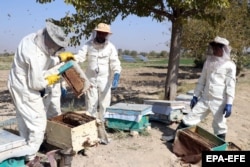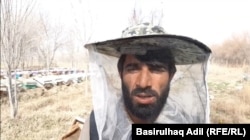Beekeeping became much more than a hobby when the industry was reborn in Afghanistan over the past two decades. For many Afghan farmers, honey became their lifeblood.
But with the decline of the Afghan economy, the sweet commodity has become a luxury item as cash-strapped customers focus their spending on basic food staples and other necessities. And with the Afghan product competing on the shelves with cheaper imports, beekeepers have been left with a glut of honey they cannot sell.
Ghancha Gul was one of the beneficiaries of the industry’s revival, which aside from providing an additional option for farmers also offered a viable entrepreneurial career for many women.
Known as the “mother of bees,” Gul has plied her trade as the owner of a beekeeping farm in the western province of Herat for 13 years, often dressing in men’s clothing to avoid discrimination as she traveled by motorcycle to deliver honey to local markets.
Business was good for years, she told RFE/RL’s Radio Azadi last month. But that was before the Taliban seized power in 2021, which triggered a devastating economic crisis that led to soaring inflation and mass unemployment and took a toll on household incomes and their purchasing preferences.
Farmers have also been hit hard by drought and floods, while the sharp rise in prices for food, fuel, and fertilizer have greatly increased their operating costs.
"I used to sell between 30 and 40 kilos of honey each month, but now I sell between 10 and 15 kilos,” Gul said. These days, she explained, “instead of buying honey, people buy rice and oil.”
Sting Of Success
International efforts were made over the past two decades to boost the industry as an alternative to opium-poppy cultivation.
The province became one of the centers of the fledgling honey-production industry, boasting about 800 beekeeping farms that employed around 3,000 people, about 10 percent of them women. Beekeeping enterprises have also been prominent in eastern Nangarhar Province and the southern provinces of Helmand and Kandahar.
Seen as an effective way to alleviate poverty in rural areas while also protecting biodiversity and supporting food security, the UN’s Food and Agriculture Organization has continued to boost the industry with training programs and the provision of startup kits, including tens of thousands of honeybees, hive boxes, and beekeeping suits, to get new farmers on their way.
The Taliban government, which has dealt with a free-falling economy and a raft of environmental disasters that have hit the agricultural sector, has also supported beekeeping.
Last year, the Taliban authorities announced the expansion of the industry with more than 400 new beekeeping farms in Helmand as well as the establishment of a berry forest in Nangarhar to sustain the local honeybee population.
The efforts to build the industry had opened export markets to countries like Kuwait, the United Arab Emirates, and India, as well as neighboring Iran and Pakistan. But while honey production showed resilience to the droughts that have ravaged Afghanistan’s agriculture sector in recent years, the export market has largely dried up, leaving beekeepers to compete with cheaper imports from Pakistan and Iran as they try to sell their product to Afghans.
In Helmand alone, honey production rose “significantly” last year following a drought-hit season that saw nearly 40 tons of honey produced in the province in 2021, according to the region’s deputy director of agriculture, Mawlawi Zainullah Zahid.
In Herat, officials suggested that production this year could nearly double to 150 tons, even as many beekeepers and honey processors reduce production as supply swells.
Other provinces have reported similar increases in production in recent years, greatly adding to the reported output of 2,150 tons produced nationwide in 2019.
Glut Of Honey
Khalil Ahmadi Bahmanesh, a beekeeper in Herat, said that half of his yield from last season has gone unsold, and that he cannot compete with imports from Iran.
"While we produce good honey, poor quality Iranian honey saturates the Herat market,” Bahmanesh said. “Iranian honey is sold at a cheap price and leads people to question purchases of our honey.”
Mohammad Aref, who started his beekeeping farm in Helmand’s Karukh district more than a decade ago with just two hives, now has more than 400.
He told Radio Azadi last year that his yields had risen more than 40 percent over the previous season but that he was unable to sell his product in the face of Iranian competition.
“When there are no patrons or customers, we are forced to avoid investing in the next season, to transfer our capital to another sector, or stop altogether," Aref said.
Shir Agha, who manages 160 hives in Helmand, says he has more than 3,000 kilograms of honey that he cannot sell.
"There are no sales. Honey is still left over from last year. There is no market,” Agha said. “At the same time, we are punished by the honey from Iran and Pakistan."
Whereas a kilogram of Afghan honey used to sell for about 1,000 afghanis ($11), producers say, the same amount of Iranian honey costs only 150 to 400 afghanis ($1.70 to $4.50).
Aziz Naseri, who runs a honey shop in Lashkargah, the provincial capital of Helmand, says he has been forced to lower his prices for Afghan honey by half.
“People's economic situation is bad,” he said. “When we look at them, we sell our honey for 700 afghanis ($7.85)."
While Seyyed Masoom Sadat, the head of Herat’s Agriculture Department, says that the province is more than self-sufficient and there is no need to import honey, the rules of international commerce prevent the elimination of competition.
“We cannot ban the import of Iranian honey because of [Afghanistan’s] membership in the World Trade Organization,” he said.
Agriculture officials in the province have said they are working to find suitable markets to boost honey sales.










